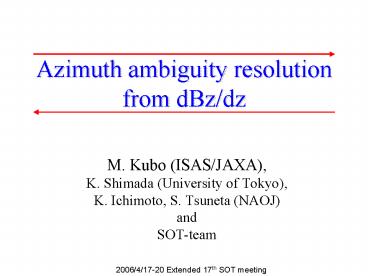Azimuth ambiguity resolution from dBzdz - PowerPoint PPT Presentation
1 / 16
Title:
Azimuth ambiguity resolution from dBzdz
Description:
the azimuth angle is determined. We calculate the sign of dBz/dz by using ... We try to resolve the azimuth ambiguity from only B = 0 with ... – PowerPoint PPT presentation
Number of Views:83
Avg rating:3.0/5.0
Title: Azimuth ambiguity resolution from dBzdz
1
Azimuth ambiguity resolution from dBz/dz
- M. Kubo (ISAS/JAXA),
- K. Shimada (University of Tokyo),
- K. Ichimoto, S. Tsuneta (NAOJ)
- and
- SOT-team
2
Azimuth ambiguity
- Resolution of azimuth ambiguity is very
important for - - determination of magnetic field structure.
- - calculation of shear angle, current density,
and helicity. - We try to resolve the azimuth ambiguity from
only ??B 0 with - no assumption (L. Wu G. Ai, 1990, ACTA).
- Magnetic fields must satisfy ??B 0 .
dBz/dz lt 0
dBz/dz gt 0
If we can know sign of dBz/dz, the azimuth
angle is determined. We calculate the sign of
dBz/dz by using (1) two different photospheric
line profiles (Fe I 6301.5Å and Fe I 6302.5Å) (2)
line-core and wing of one photospheric line
profile (Fe I 6301. 5Å)
Bx, By
Bx, By
3
dBz/dz from two different line profiles
- We obtain two Bz values using Fe I 6301.5Å and
Fe I 6302.5Å lines. - - SOT/SP obtains full stokes profiles of Fe I
6301.5Å and Fe I 6302.5Å. - Milne-Eddington inversion code is applied for
each line - to derive the magnetic field strengths with
different height. - Formation height of Fe I 6301.5Å is slightly
higher than that of Fe I 6302.5Å. - Bz (6301.5Å) - Bz (6302.5Å) gt0
- ? dBz/dz gt 0
- Bz (6301.5Å) - Bz (6302.5Å) lt0
- ? dBz/dz lt 0
Stokes V profile
4
Test Case
- We use Holweger Muller model atmosphere to
make synthesized Stoke profiles. - Field strength has height gradient (dB/d? ?
300), - and inclination does not vary with height.
- We examine 36 cases for dBz/dz gt0 and 36 cases
for dBz/dz lt0.
inclination 0 vertical to the solar surface,
90 horizontal to the solar surface
5
Result1
- A percentage of correct answers for both ?
dBz/dz is 39 (14/36). - When filling factor becomes a free parameter,
the percentage increases to 67 . - The percentage of correct answers are not
improved when thermodynamic - parameters are fixed to values derived from
both lines or when weight of - Stokes-V increases in the ME inversion.
dBz/dz gt 0
input parameters ? ? 10 deg ? ? 45
deg ? 80 deg red dBz/dz gt 0 blue
dBz/dz lt 0
dBz/dz lt 0
(Filling factor are fixed to 1 in this case.)
6
Result1
- A percentage of correct answers for both ?
dBz/dz is 39 (14/36). - When filling factor becomes a free parameter,
the percentage increases to 67 . - The percentage of correct answers are not
improved when thermodynamic - parameters are fixed to values derived from
both lines or when weight of - Stokes-V increases in the ME inversion.
dBz/dz gt 0
input parameters ? ? 10 deg ? ? 45
deg ? 80 deg red dBz/dz gt 0 blue
dBz/dz lt 0
dBz/dz lt 0
(Filling factor are fixed to 1 in this case.)
7
Difference of response function between line-core
and wing
- We investigate difference between two Bz
- values derived from Stokes profiles
- around line core and wing.
- The line core profile represents magnetic fields
- in the upper atmosphere in comparison with
- magnetic fields derived from the wing.
- Bz (line core) - Bz (wing) gt 0 ? dBz/dz gt 0
- Bz (line core) - Bz (wing) lt 0 ? dBz/dz lt 0
- The line core is defined as line center ? 70 mÅ.
- The wing is defined as -300mÅ to -70 mÅ.
- We use Fe I 6301.5Å, because a response
- function of Stokes V to Bz for Fe I 6301.5Å
- is sharper than that of Fe I 6302.5Å.
Response function of Stokes-V to Bz
Line center 6301.5Å
Stokes V profile (6301.5Å)
8
Result2
- A percentage of correct answers for both ?
dBz/dz is 86 (31/36), and - it increase to 97 (29/30) for field strength gt
500 Gauss. - We may have to change wavelength sampling for
line-core and wing - with a width of Zeeman splitting.
dBz/dz gt 0
input parameters ? ? 10 deg ? ? 45
deg ? 80 deg red dBz/dz gt 0 blue
dBz/dz lt 0
dBz/dz lt 0
(Filling factor and Doppler shift are fixed to 1
and 0 respectively in this case.)
9
Summary and Future Works
- Difference between the response functions of
Stokes V for line-core - and wing would be useful for calculating the
sign of dBz/dz. - - We have to test this method for
- (1) many cases with various parameters
(Doppler, filling factor..) - (2) profiles including noise
- (3) observed Stokes profile
- We like to find the best way to calculate the
sign of dBz/dz. - - We will try to derive the sign of dBz/dz by
using - (1) Neural network
- (2) PCA
- (3) Inversion with height gradient
- (4) etc
10
(No Transcript)
11
Stokes V profiles fitted for line core and wing
A
C
B
input
line core
wing
12
Response function of Stokes-V to Bz, FeI6302.5A
13
Response function of Stokes-V to Bz, FeI6301.5A
14
l -168 168mA
15
6301.5A
6302.5A
16
FeI6302.5A Bt100G
Residual of ME fit































